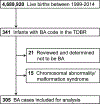The Epidemiology of Biliary Atresia: Exploring the Role of Developmental Factors on Birth Prevalence
- PMID: 35364097
- PMCID: PMC9332904
- DOI: 10.1016/j.jpeds.2022.03.038
The Epidemiology of Biliary Atresia: Exploring the Role of Developmental Factors on Birth Prevalence
Abstract
Objective: To identify key epidemiologic factors relevant to fetal development that are associated with biliary atresia.
Study design: This population-based registry study examined infants born in Texas between 1999 and 2014. Epidemiologic data relevant to fetal development were compared between cases of biliary atresia identified in the Texas Birth Defects Registry (n = 305) vs all live births (n = 4 689 920), and Poisson regression was used to calculate prevalence ratios (PRs) and 95% CIs.
Results: The prevalence of biliary atresia over the study period was 0.65 per 10 000 live births. Biliary atresia was positively associated with female sex (adjusted PR, 1.68; 95% CI, 1.33-2.12), delivery before 32-37 weeks of gestation (adjusted PR, 1.64; 95% CI, 1.18-2.29), delivery before 32 weeks of gestation (adjusted PR, 3.85; 95% CI, 2.38-6.22), and non-Hispanic Black vs non-Hispanic White maternal race/ethnicity (adjusted PR, 1.54, 95% CI, 1.06-2.24), while biliary atresia was inversely associated with season of conception in the fall relative to spring (adjusted PR, 0.62; 95% CI, 0.45-0.86). In addition, biliary atresia was associated with maternal diabetes (adjusted PR, 2.34; 95% CI, 1.57-3.48), with a stronger association with pregestational diabetes compared with gestational diabetes. In subgroup analyses, these associations were present in isolated biliary atresia cases that do not have any additional birth defects.
Conclusions: Biliary atresia is associated with multiple factors related to fetal development, including pregestational maternal diabetes, female sex, and preterm birth. These associations also were observed in isolated cases of biliary atresia without other malformations or laterality defects. Our results are consistent with early life events influencing the pathogenesis of biliary atresia, and support further studies investigating in utero events to better understand etiology and time of onset.
Keywords: maternal diabetes; prematurity.
Copyright © 2022 Elsevier Inc. All rights reserved.
Conflict of interest statement
Figures


Comment in
-
Nature or Nurture in the Pathogenesis of Biliary Atresia?J Pediatr. 2022 Jul;246:10-11.e1. doi: 10.1016/j.jpeds.2022.04.047. Epub 2022 May 2. J Pediatr. 2022. PMID: 35513068 No abstract available.
References
-
- Jimenez-Rivera C, Jolin-Dahel KS, Fortinsky KJ, Gozdyra P, Benchimol EI. International incidence and outcomes of biliary atresia. J Pediatr Gastroenterol Nutr. 2013. Apr;56:344–54. - PubMed
-
- Feldman AG, Mack CL. Biliary Atresia. J Pediatr Gastroenterol Nutr. 2015. Aug;61:167–75. - PubMed
-
- Fallon SC, Chang S, Finegold MJ, Karpen SJ, Brandt ML. Discordant presentation of biliary atresia in premature monozygotic twins. J Pediatr Gastroenterol Nutr. 2013. Oct;57:e22–3. - PubMed
Publication types
MeSH terms
Grants and funding
LinkOut - more resources
Full Text Sources
Research Materials

